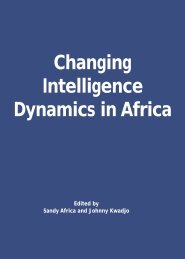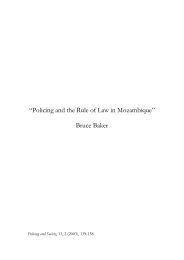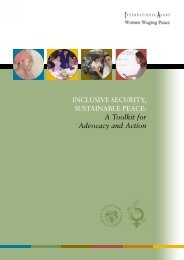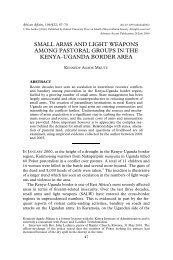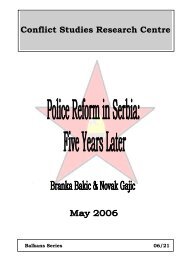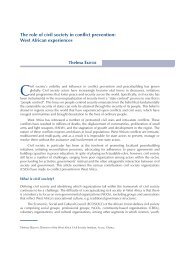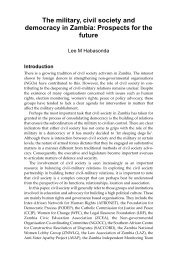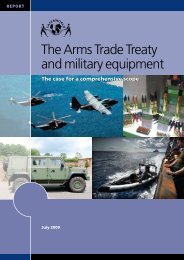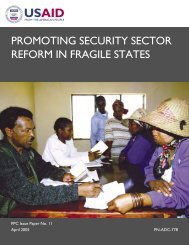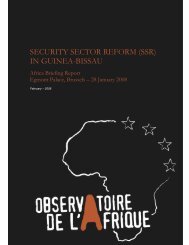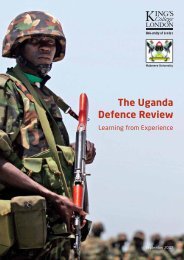AFGHANISTAN'S ELECTION CHALLENGES
AFGHANISTAN'S ELECTION CHALLENGES
AFGHANISTAN'S ELECTION CHALLENGES
You also want an ePaper? Increase the reach of your titles
YUMPU automatically turns print PDFs into web optimized ePapers that Google loves.
Afghanistan’s Election Challenges<br />
Crisis Group Asia Report N°171, 24 June 2009 Page 5<br />
by end-2011. 31 An earlier assessment noted that only<br />
around a quarter of 72 ANA units were capable of<br />
operating independently. 32<br />
Provision of security is central to perceptions of government<br />
legitimacy. In December 2008, the United<br />
Nations Assistance Mission to Afghanistan (UNAMA)<br />
estimated that of some 350-plus districts, the government<br />
did not control ten, with access to a further 165<br />
difficult or problematic. 33 Even in areas with government-controlled<br />
district centres, insurgents may<br />
exercise influence over the surrounding countryside and<br />
road networks with the violence steadily expanding –<br />
often through short-term alliances with criminal or<br />
other non-ideological groups – from the south and<br />
east to the west as well as pockets in the north. The<br />
campaign of terror has focused on police and others involved<br />
with the government. For instance, the provincial<br />
council secretary of Nangarhar was gunned down<br />
in February 2009 and a female Kandahar provincial<br />
councillor assassinated in April. There have been repeated<br />
suicide attacks on the Kandahar provincial<br />
council’s meeting place, sending a chilling message<br />
prior to the election.<br />
Operating under the banner of their old regime, the<br />
Islamic Emirate of Afghanistan, the Taliban has succeeded<br />
in attracting a diverse array of commanders and<br />
networks to join the insurgency. This includes the<br />
Haqqani network in the south east, blamed for a series<br />
of sophisticated multi-pronged attacks in Kabul, which<br />
bear the hallmark of patronage from the international<br />
jihadi networks, while Gulbuddin Hekmatyar’s Hizb-e<br />
Islami operates in the north, east and centre of the<br />
country. 34<br />
Growing disillusionment with governance and the<br />
absence of security and basic services provide fertile<br />
ground for the recruitment of foot soldiers to join the<br />
insurgency. Less ideological armed groups and criminal<br />
elements, including drug traffickers, are also taking<br />
advantage of the increasing lawlessness. Spiralling<br />
31 Ibid.<br />
32 “Report on progress towards security and stability in Afghanistan”,<br />
U.S. Department of Defense, op. cit., p. 42. In<br />
September 2008 it was agreed by the JCMB to increase the<br />
target size of the ANA from 84,000 to 134,000.<br />
33 “The Situation in Afghanistan and its Implications for<br />
International Peace and Security”, UN document A/63/751 –<br />
S/2009/135, 10 March 2009, p. 5.<br />
34 The remnants of Hizb-e Islami (Khalis), directed by his<br />
son as the Tora Bora Military Front, claims allegiance to<br />
the Taliban, as does the Mansoor network of the south east.<br />
See Crisis Group Reports, Countering Afghanistan’s Insurgency:<br />
No Quick Fixes and Taliban Propaganda: Winning<br />
the War of Words?, both op. cit.<br />
narcotics production is both a source and a symptom<br />
of insecurity. Those involved have a vested interest in<br />
opposing the rule of law even as many have taken seats<br />
at the heart of government, using their official positions<br />
to facilitate business and their money to buy more<br />
influence.<br />
Regionally the situation has deteriorated significantly.<br />
The Pakistan military’s jihadi proxies, used as policy<br />
instruments in both Afghanistan and India, have expanded<br />
their influence and control over parts of northern<br />
Pakistan, including the regions that border on<br />
south-eastern Afghanistan. They are actively support-<br />
ing and fighting alongside Afghan insurgents. 35<br />
The escalating insurgency could have a number of<br />
potential impacts on the electoral process in 2009 and<br />
2010. Most obviously it could mean a low turnout in the<br />
areas of greater violence and intimidation, as well as<br />
less observation and scrutiny of the process in such<br />
areas, increasing opportunities for large-scale fraud.<br />
With the insurgency centred in the Pashtun-dominated<br />
areas of the south and east and thus mostly impacting<br />
the ballots of one ethnic group, any effects on the perceived<br />
legitimacy of the polls are multiplied.<br />
C. 8PATRONAGE POLITICS<br />
There has been little incentive for interest groups to<br />
coalesce and stabilise in the absence of robust political<br />
parties and with governance marred by the politics of<br />
patronage and personal privilege. 36 The leaders of<br />
mujahidin-era Islamist political groupings, known as<br />
tanzims, and individual powerbrokers still dominate<br />
politics. Fluid and opaque alliances make it difficult<br />
to distinguish the government from the opposition. New,<br />
small “democratic” parties have failed to make much<br />
headway. 37 With few institutional incentives to be part<br />
35 There are no signs of Pakistani action against the Afghan<br />
Taliban presence or that of the Haqqani network and Hekmatyar’s<br />
Hizb-e Islami. The Pakistani military offensive in<br />
Swat or the planned operation in South Waziristan Agency<br />
in the Federally Administered Tribal Areas is unlikely to<br />
curb cross-border violence unless the military ends its policy<br />
of supporting some Pakistani Taliban groups, even as it<br />
confronts those that are now targeting Pakistan itself. See<br />
Crisis Group Asia Reports N°164, Pakistan: The Militant<br />
Jihadi Challenge, 13 March 2009; and N°125, Pakistan’s<br />
Tribal Areas: Appeasing the Militants, 11 December 2006.<br />
36 For more on political manoeuvring prior to 2005 see Crisis<br />
Group Briefing, Political Parties in Afghanistan, op.<br />
cit.; and Crisis Group Report, Afghanistan’s New Legislature:<br />
Making Democracy Work, op. cit.<br />
37 See Anna Larson, “Afghanistan’s New Democratic Parties:<br />
A Means to Organise Democratisation?”, AREU, March 2009.



